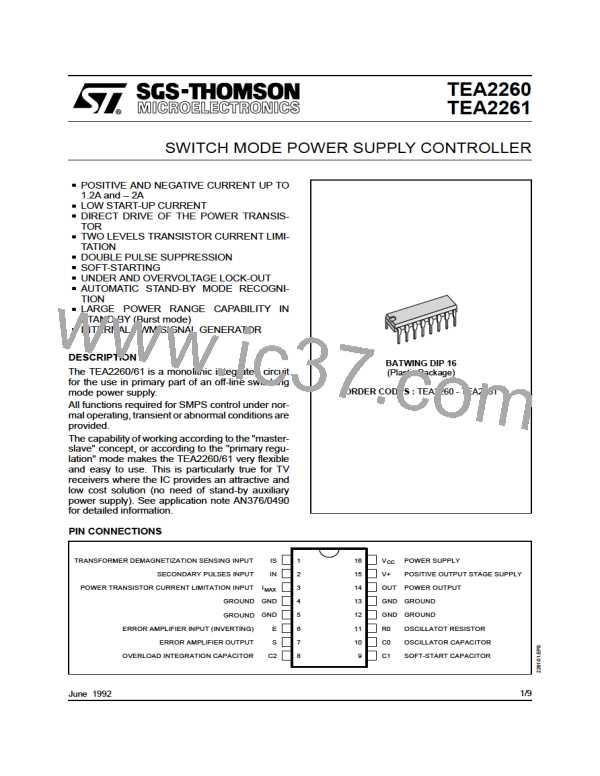TEA2260 - TEA2261
GENERAL DESCRIPTION
system is used, in order to avoid audible noise.
The TEA2260/61 is an off-line switch mode power
supply controller. The synchronization function and
thespecificoperationinstand-bymodemake itwell
adapted to video applications such as TV sets,
VCRs, monitors, etc...
Normal Mode (secondary regulation)
The normal operating of the TV set is obtained by
sending to the TEA2260/61 regulation pulses gen-
erated by a regulator located in the secondary side
of the power supply.
This architecture uses the "Master-slave Concept",
advantages of which are now well-known espe-
ciallythe veryhighefficiency instand-bymode, and
the accurate regulation in normal mode.
Stand-by mode or normal mode are obtained by
supplying or not the secondary regulator. This can
be ordonnered for exemple by a microprocessor in
relation with the remote control unit.
Regulation pulses are applied to the TEA2260/61
through a small pulse-transformer to the IN input
(Pin 2). This input is sensitive to positive square
pulses. The typical threshold of this input is 0.85V.
The frequency of pulses coming from the secon-
dary regulator can be lower or higher than the
frequency of the starting oscillator.
The TEA2260/61 has no soft-starting system when
it receives pulses from the secondary. The soft-
starting has to be located in the secondary regula-
tor.
Due to the principle of the primary regulation,
pulses generated by the starting system automat-
ically disappear when the voltage delivered by the
SMPS increases.
The TEA2260/61 can be used in two types of
architectures :
- Master/slave architecture. In this case, the
TEA2260/61 drives the power transistor accord-
ing to the pulse width modulated signals gener-
ated by the secondary located master circuit. A
pulse transformer provides the feedback (see
Figure 1).
- Conventional architecture with linear feedback
signal (feedback sources : optocoupler or trans-
former winding) (see Figure 2).
Using the TEA2260/61, the stand-by auxiliary
power supply, often realized with a small but costly
50Hz transformer, is no longer necessary. The
burst mode operation of the TEA2260/61 makes
possible the control of very low output power (down
to less than 1W) with the main power transformer.
When used in a master/slave architecture, the
TEA2260/61 and also the power transistor turn-off
can be easily synchronized with the line trans-
former. The switching noise cannot disturb the
picture in this case.
As an S.M.P.S. controller, theTEA2260/61features
the following functions :
- Power supply start-up (with soft-start)
- PWM generator
- Direct power transistor drive (+1.2A, -2.0A)
- Safety functions : pulse by pulse current limita-
tion, output power limitation, over and under volt-
age lock-out.
Stand-by Mode - Normal Mode Transition
During the transition there are simultaneously
pulses coming from the primary and secondary
regulators.
These signals are not synchronized and some care
has to betaken toensurethe safety oftheswitching
power transistor.
A very sure and simple way consist in checking the
transformer demagnetization state.
- A primary pulse is taken in account only if the
transformer is demagnetized after a conduction
of the power transistor required by the secondary
regulator.
- A secondary pulse is taken in account only if the
transformer is demagnetized after a conduction
of the power transistor required by the primary
regulator.
S.M.P.S. OPERATING DESCRIPTION
Starting Mode - Stand By Mode
Power for circuit supply is taken from the mains
through a high value resistor before starting. As
long as VCC of the TEA2260/61 is below VCC start,
the quiescent current is very low (typically 0.7mA)
and the electrolytic capacitor across VCC is linearly
charged. When VCC reaches VCC start (typically
10.3V), the circuit starts, generating output pulses
with a soft-starting. Then the SMPS goes into the
stand-by mode and the output voltage is a percen-
tage of the nominal output voltage (eg. 80%).
For this the TEA2260/61 contains all the functions
required for primary mode regulation : a fixed fre-
quency oscillator, a voltage reference, an error
amplifier and a pulse width modulator (PWM).
For transmission of low power with a good effi-
ciency in stand-by, an automatic burst generation
With this arrangement the switching safety area of
the power transistor is respected and there is no
risk of transformer magnetization.
The magnetization state of the transformer is
checked by sensing the voltage across a winding
of the transformer (generally the same which sup-
plies the TEA2261). This is made by connecting a
resistor between this winding and the demagneti-
zation sensing input of the circuit (Pin 1).
5/9

 STMICROELECTRONICS [ ST ]
STMICROELECTRONICS [ ST ]